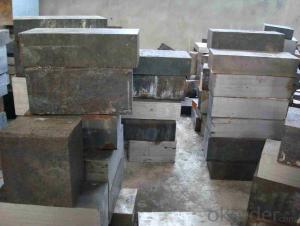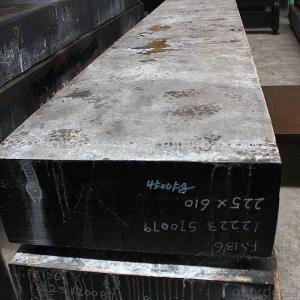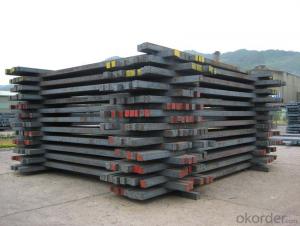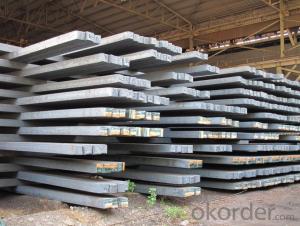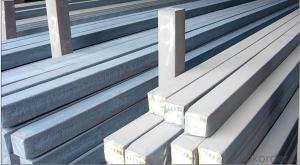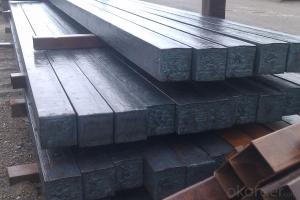Hot Rolled Steel Billet 3SP Standard 130mm
- Loading Port:
- Shanghai
- Payment Terms:
- TT OR LC
- Min Order Qty:
- 100 m.t.
- Supply Capability:
- 10000 m.t./month
OKorder Service Pledge
OKorder Financial Service
You Might Also Like
Structure of Hot Rolled Steel Billet 3SP Standard 130mm

Description of Hot Rolled Steel Billet 3SP Standard 130mm
Prepainted Rolled steel Coil is a kind of coated steel coil/sheet. With the cold rolled steel of different strength and thickness as substrate, it is produced through applying Al-Zn coat on both faces by hot dip process. In its coating, Al accounts for about 55%, Si 1.6%, while the remaining is Zn. Aluminum zinc coils enjoys both the physical protective feature and durability of Al and the electrochemical protective property of Zn. And its surface has bright silver color and regular embossed-like figure, which are highly decorative. RAL Scale Z35 Prepainted Rolled Steel Coil for Construction Roofing

Main Feature of Hot Rolled Steel Billet 3SP Standard 130mm
1.Corrosion resistance: It mainly depends on the zinc protection. When the zinc being worn,
2. Heat resistance: steel sheet has excellent heat resistance, can withstand high temperatures over 300 centigrade, and is similar with aluminized steel high temperature oxidation resistance. It often used in chimney pipes, ovens, fluorescent lighting device and the device cover.
3. Heat reflective: Galvanized steel plate heat-reflective high rate is twice as galvanized steel, often used to make insulation materials. RAL Scale Z35 Prepainted Rolled Steel Coil for Construction Roofing
Applications of Hot Rolled Steel Billet 3SP Standard 130mm
1. Construction and building: roofing; ventilating duct; handrail; partition panel;etc.
2. Electric appliance: refrigerator; washing machine; refrigerator; DVD;etc.
3.Transportation: oil tank; gas tank;road sign; etc.
4.Agriculture constructions :barn; etc.RAL Scale Z35 Prepainted Rolled Steel Coil for Construction Roofing
5.Others:vending machine; game machine; auto parts spare parts etc.
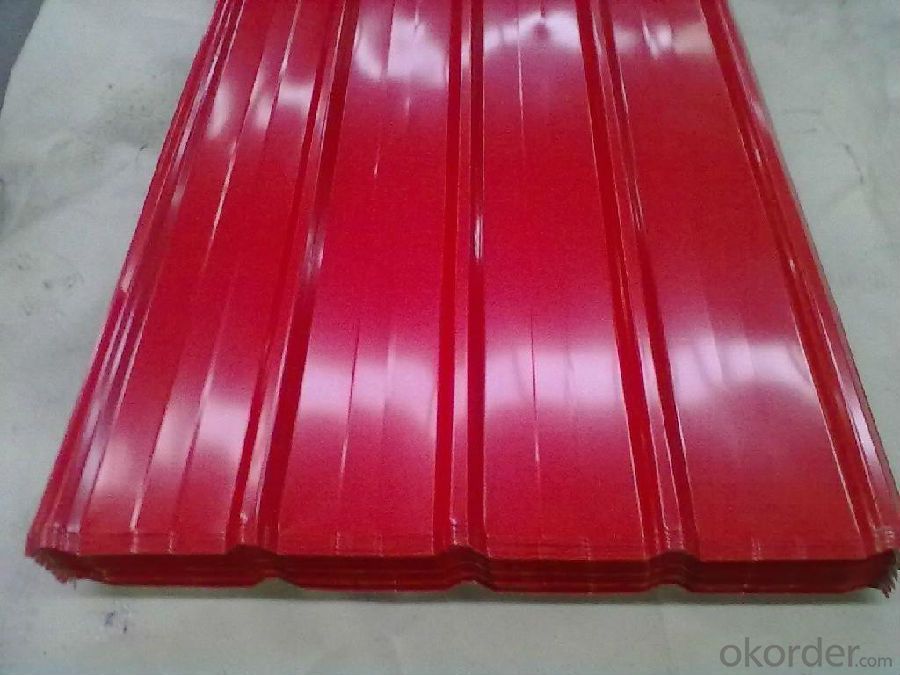
Specifications of Hot Rolled Steel Billet 3SP Standard 130mm
Product | Hot Rolled Steel Billet 3SP Standard 130mm |
Material Grade | SGCC / SGCH / DX51D+AZ, etc |
Thickness | 0.5-3.0mm |
Width | 700-1500mm |
Tolerance | Thickness: +/-0.02mm , Width:+/-2mm |
Zinc-coating | AZ30-150g/m2 |
Technique | Raw material: Hot rolled steel coil --> Cold rolled_>hot dipped galvalume |
Surface | Dried, Chromated, Unoiled,RAL Scale Z35 Prepainted Rolled Steel Coil for Construction Roofing |
Spangle | Regular spangle , small spangle, zero spangle |
ID | 508MM 610MM |
Coil weight | 25MT max |
Export package | Cardboard inner sleeves, Waterproof paper, galvanized steel covered and steel strip packed |
FAQ of Hot Rolled Steel Billet 3SP Standard 130mm
We have organized several common questions for our clients,may help you sincerely:
1. What is the minimum order quantity ?
Our MOQ is 100 mt for each size each specification. Usually we can offer discount if can buy large QTY once. RAL Scale Z35 Prepainted Rolled Steel Coil for Construction Roofing
2. How long can we receive the product after ordering?
Our general delivery time is 30 days after confirmation, but so some special orders, we have offer special delivery time
3. How to guarantee the quality of the products?
We have established the international advanced quality management system ,every link from raw material to final product we have strict quality test;We resolutely put an end to unqualified products flowing into the market. At the same time, we will provide necessary follow-up service assurance.
4. What is the payment?
We accept T/T, L/C
- Q:What is the role of steel billets in the production of automotive components?
- Steel billets play a crucial role in the production of automotive components. These billets are semi-finished metal products that serve as the raw material for various parts used in the automotive industry. Firstly, steel billets are used to manufacture engine components such as crankshafts, camshafts, and connecting rods. These are vital parts that contribute to the smooth functioning of the engine. The strong and durable properties of steel make it an ideal material for these components, ensuring they can withstand the high temperatures and pressures within the engine. Secondly, steel billets are used to produce chassis and suspension components. These include parts like control arms, steering knuckles, and axle shafts, which are responsible for the vehicle's stability, maneuverability, and overall performance. Steel's high strength-to-weight ratio and excellent fatigue resistance make it suitable for these safety-critical components. Furthermore, steel billets are utilized in the production of transmission and drivetrain components. These include gears, shafts, and clutch plates, which are essential for transmitting power from the engine to the wheels. Steel's toughness, wear resistance, and ability to handle high torque loads make it an ideal material for these parts, ensuring their durability and reliability. Additionally, steel billets are used in the manufacture of body and interior components. These can include door hinges, brackets, seat frames, and various structural parts. Steel's versatility, formability, and corrosion resistance make it an excellent choice for these components, providing strength and protection to the vehicle's occupants. Overall, steel billets form the foundation for the production of a wide range of automotive components. They provide the necessary strength, durability, and reliability required for critical parts in engines, chassis, transmission systems, and body structures. Without steel billets, the automotive industry would struggle to produce high-quality and safe vehicles.
- Q:Are steel billets used in the production of musical instruments?
- Certain musical instruments use steel billets in their production. Steel billets are commonly utilized as a primary component in the manufacturing of steel-string acoustic guitars. Typically, the steel billets are molded into a solid metal rod, which is then employed to construct the guitar's neck. This guarantees that the instrument possesses the necessary strength and durability to endure the tension of the steel strings. Moreover, steel billets can also be employed in the production of other metal instruments such as drums or percussion instruments, where their strength and resilience offer advantages. Nevertheless, it is important to acknowledge that the utilization of steel billets may vary depending on the specific instrument and its manufacturing process.
- Q:How often is it? What is the range of temperature in the process of rolling? What is the temperature of the final rolling?
- The final rolling temperature is the rolling temperature of the last pass, and also the rolling temperature of the rolling pass at the last effective (very small level pass, not an effective rolling pass)
- Q:What is the standard tolerance for steel billet dimensions?
- The specific industry and application can cause variation in the standard tolerance for steel billet dimensions. Generally, the standard tolerance for steel billet dimensions ranges from ±0.005 to ±0.010 inches (±0.13 to ±0.25 mm). These tolerances ensure that the steel billets meet the necessary specifications and standards. It is worth mentioning that different industries and applications might have their own distinct tolerances based on their unique standards and requirements. Thus, it is vital to refer to the relevant industry or application-specific standards to determine the exact tolerance for steel billet dimensions.
- Q:How are steel billets used in the production of structural steel sections?
- Steel billets are a crucial component in the production of structural steel sections. These billets serve as the primary raw material for the manufacturing process. To begin with, steel billets are melted in a furnace to create molten steel. This molten steel is then cast into billets of specific sizes and shapes, which can vary depending on the desired structural steel section to be produced. The billets are typically rectangular or square in shape. Once the steel billets have solidified, they are reheated in another furnace to a specific temperature for hot rolling. Hot rolling is a process where the billets are passed through a series of rolling mills to reduce their cross-sectional area and shape them into the desired structural steel sections. This process involves applying high pressure and temperature to the billets, which causes them to deform and elongate. The hot rolled steel sections are cooled and then undergo further processing, such as straightening, cutting, and sometimes additional heat treatment to enhance their mechanical properties. These steps ensure that the structural steel sections meet the required specifications for strength, durability, and dimensional accuracy. The structural steel sections produced from steel billets are widely used in various construction projects. They are commonly used in the construction of buildings, bridges, infrastructure, and other structures where strength and load-bearing capacity are essential. These sections can be found in beams, columns, channels, angles, and other shapes that provide the necessary support and structural integrity. Overall, steel billets play a vital role in the production of structural steel sections, serving as the starting material that undergoes a series of manufacturing processes to create the final products used in construction and other industries.
- Q:What are the potential applications of steel billets in the oil and gas aftermarket?
- Steel billets have a wide range of potential applications in the oil and gas aftermarket. Firstly, steel billets can be used for the manufacturing of various components in the oil and gas industry, such as valves, flanges, and fittings. These components are essential for the operation and maintenance of pipelines, refineries, and drilling facilities. Additionally, steel billets can be used for the production of seamless pipes, which are crucial for transporting oil and gas over long distances. Seamless pipes made from steel billets offer high strength, durability, and resistance to corrosion, making them suitable for the harsh conditions often encountered in the oil and gas industry. Furthermore, steel billets can be utilized in the manufacturing of downhole tools and equipment. These tools are used during drilling operations to extract oil and gas from the ground. Steel billets provide the necessary strength and toughness required to withstand the extreme pressures and temperatures encountered in downhole environments. Moreover, steel billets can be used for the fabrication of storage tanks and vessels used in the oil and gas industry. These tanks are used for storing crude oil, refined products, and natural gas. Steel billets offer excellent weldability and structural integrity, ensuring the reliability and safety of storage facilities. Furthermore, steel billets can be used for the construction of offshore platforms and structures. These platforms are used for drilling, production, and processing activities in offshore oil and gas fields. Steel billets are favored in this application due to their high strength, corrosion resistance, and ability to withstand the harsh marine environment. In summary, the potential applications of steel billets in the oil and gas aftermarket are extensive. From the manufacturing of components, seamless pipes, and downhole tools to the fabrication of storage tanks and offshore platforms, steel billets play a vital role in supporting the operations of the oil and gas industry.
- Q:How are steel billets used in the production of valves and fittings?
- Steel billets are a crucial raw material in the production of valves and fittings. These billets, which are essentially semi-finished steel products, undergo various processes to ultimately form the desired shape and size of valves and fittings. Firstly, steel billets are heated to a specific temperature in a furnace to make them more malleable. This allows for easier shaping and manipulation of the steel during subsequent forming processes. Once heated, the billets are then transferred to a rolling mill where they are passed through multiple rollers to gradually reduce their cross-sectional area and length. This process, known as hot rolling, helps to refine the steel's grain structure and improve its mechanical properties. After hot rolling, the steel billets are often further processed through a method called extrusion. In this process, the heated billet is forced through a die, which imparts the desired shape and dimensions onto the steel. Extrusion is commonly used to produce cylindrical or tubular shapes, which are essential components in valves and fittings. Once the desired shape is achieved, the extruded steel is generally subjected to heat treatment processes such as quenching and tempering to enhance its strength and durability. This helps to ensure that the final valves and fittings can withstand the demanding conditions they will be subjected to during their operational life. Finally, the heat-treated steel is machined and finished to meet the specific requirements of the valves and fittings. This includes processes such as drilling, threading, and surface finishing to achieve the necessary dimensions, threads, and smoothness. In summary, steel billets are transformed into valves and fittings through a series of processes including heating, hot rolling, extrusion, heat treatment, and machining. These processes ensure that the resulting valves and fittings possess the necessary strength, durability, and dimensional accuracy required for their intended applications.
- Q:What are the factors that affect the quality of steel billets?
- There are several factors that can affect the quality of steel billets, including the composition of the raw material used, the temperature and duration of the melting process, the presence of impurities, the cooling rate during solidification, and the subsequent heat treatment processes. Other factors may include the equipment used for casting and rolling, the control of process parameters, and the overall quality management system in place.
- Q:How do steel billets contribute to the manufacturing of furniture?
- The manufacturing of furniture relies heavily on steel billets, which serve as the essential raw material needed to create strong and durable frames. These billets, produced through casting or hot rolling, are semi-finished steel products with a rectangular shape. After obtaining the steel billets, they can undergo various manufacturing techniques such as forging, extrusion, or machining to shape them into different furniture components. These components include frames for chairs, tables, beds, and other elements that require stability and strength. Using steel billets in furniture manufacturing offers several advantages. Firstly, steel is renowned for its exceptional strength and durability, making it an ideal material for furniture that can handle heavy loads and regular use. By utilizing steel billets, the furniture becomes robust and long-lasting, reducing the need for frequent replacements. In addition, steel billets provide design flexibility as they can be easily molded and shaped into different forms. This allows furniture manufacturers to create intricate and unique designs that meet customers' aesthetic preferences. Moreover, steel billets can be seamlessly welded, resulting in a more cohesive and visually appealing final product. Furthermore, steel is highly resistant to corrosion, which is crucial for furniture that may be exposed to moisture or environmental factors. By incorporating steel billets, the furniture remains free from corrosion, preserving its appearance and structural integrity over time. In conclusion, steel billets are indispensable in furniture manufacturing as they provide the necessary strength, durability, and flexibility to create sturdy frames and structural components. Their utilization enables furniture manufacturers to produce high-quality products that are long-lasting, visually appealing, and resistant to corrosion.
- Q:How do steel billets contribute to the automotive industry?
- Steel billets play a crucial role in the automotive industry as they are the raw materials used to manufacture various components such as engine blocks, transmission gears, axles, and chassis. These billets are forged and shaped into specific parts, providing the required strength, durability, and performance characteristics needed for automobiles. Additionally, steel billets offer excellent resistance to corrosion and high temperatures, ensuring the safety and reliability of vehicles on the road.
1. Manufacturer Overview |
|
|---|---|
| Location | |
| Year Established | |
| Annual Output Value | |
| Main Markets | |
| Company Certifications | |
2. Manufacturer Certificates |
|
|---|---|
| a) Certification Name | |
| Range | |
| Reference | |
| Validity Period | |
3. Manufacturer Capability |
|
|---|---|
| a)Trade Capacity | |
| Nearest Port | |
| Export Percentage | |
| No.of Employees in Trade Department | |
| Language Spoken: | |
| b)Factory Information | |
| Factory Size: | |
| No. of Production Lines | |
| Contract Manufacturing | |
| Product Price Range | |
Send your message to us
Hot Rolled Steel Billet 3SP Standard 130mm
- Loading Port:
- Shanghai
- Payment Terms:
- TT OR LC
- Min Order Qty:
- 100 m.t.
- Supply Capability:
- 10000 m.t./month
OKorder Service Pledge
OKorder Financial Service
Similar products
New products
Hot products
Related keywords
